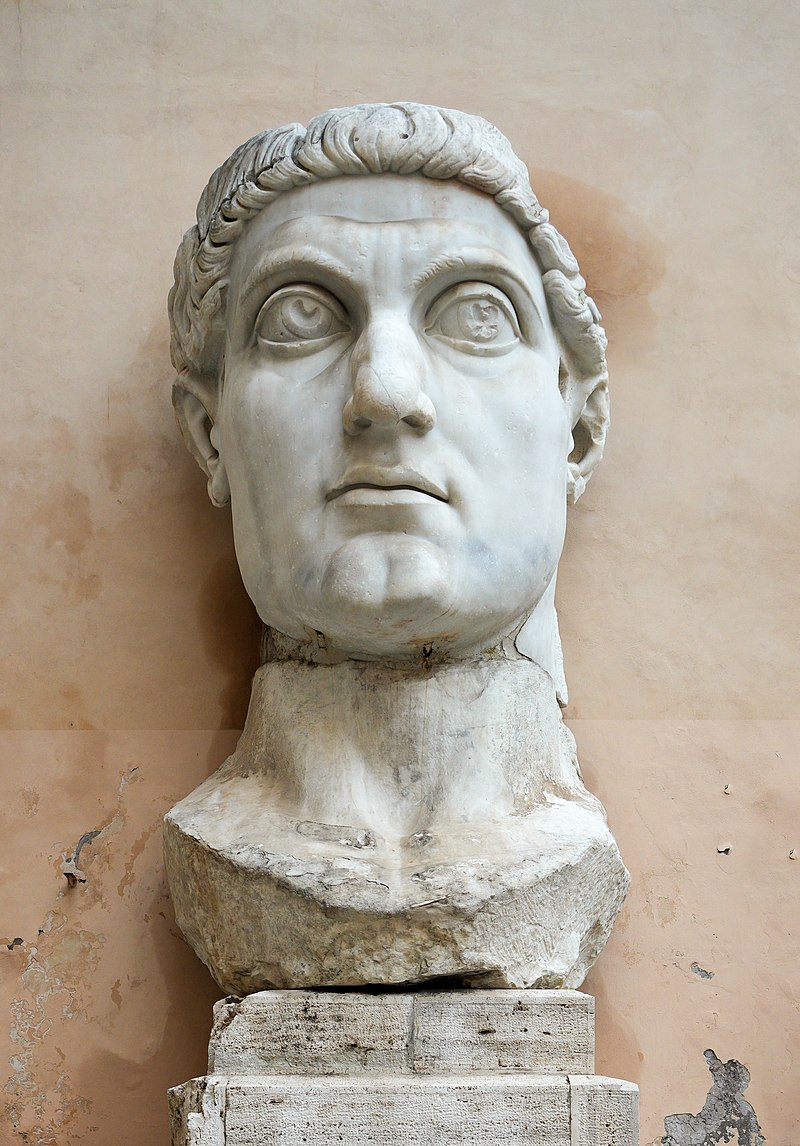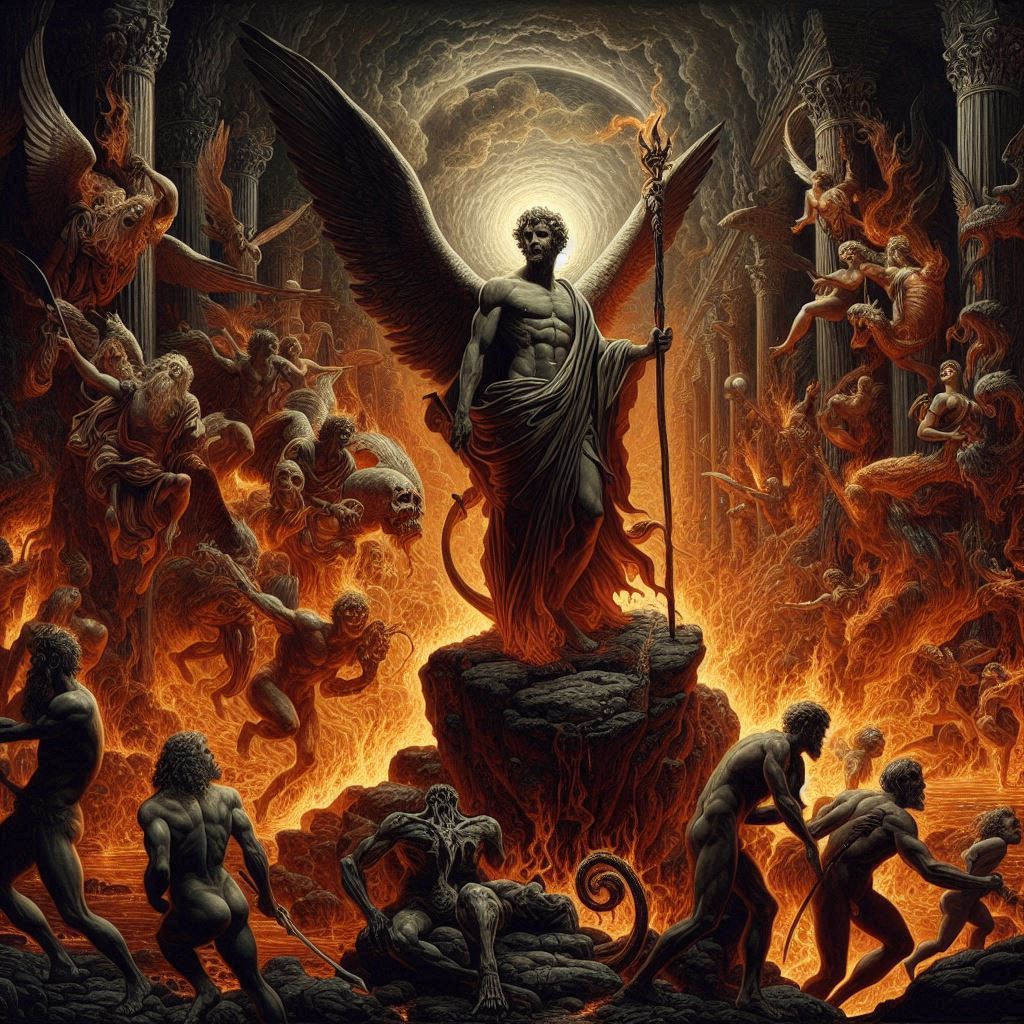Constantine the Great (272-337 AD), also known as Flavius Valerius Constantinus, was a Roman emperor who ruled from AD 306 to 337. He is best known for being the first Roman emperor to convert to Christianity and for the Edict of Milan in AD 313, which granted religious tolerance to Christians in the Roman Empire. Constantine played a significant role in the transition from the Roman Empire’s paganism to Christianity and is often credited with contributing to the Christianization of the Roman world.
Early Life and Rise to Power
Flavius Valerius Constantinus, later known as Constantine the Great, entered the world in the year AD 272 in the city of Naissus, located in the province of Moesia (modern-day Niš, Serbia). Born into a distinguished family, his father, Constantius Chlorus, was a Roman military officer of Illyrian descent, and his mother, Helena, came from humble origins. Little did they know that their son would become one of the most influential figures in Roman history.
Constantine’s early years were marked by a series of familial and geographical upheavals. His father’s military career propelled the family to different corners of the vast Roman Empire. Constantius Chlorus served under Emperor Diocletian, and as a result, Constantine’s upbringing exposed him to the diverse cultures and challenges that characterized the empire during this period.
In AD 293, Constantine’s life took a significant turn when his father was appointed as one of the two Augusti, the Western Roman Emperor. The imperial court became Constantine’s new environment, and he found himself at the center of political and military affairs. However, this period of relative stability within the imperial family was fleeting. In AD 306, Constantius Chlorus fell ill and died in Eboracum (modern-day York, England), while campaigning against the Picts.
Constantine’s world was thrust into chaos with his father’s death. The legions stationed in Britain proclaimed him as Augustus, setting the stage for a power struggle for control of the Western Roman Empire. Constantine faced challenges from other claimants, including Maxentius, who controlled Italy and parts of North Africa. The situation became increasingly precarious, forcing Constantine to navigate a complex web of loyalties and rivalries.
The year AD 312 proved pivotal in Constantine’s rise to power. Facing the threat posed by Maxentius, who had declared war against him, Constantine embarked on a campaign to secure his position. The Battle of Milvian Bridge, fought on October 28, AD 312, near Rome, became a defining moment in his life. According to historical accounts, Constantine experienced a vision the night before the battle, in which he saw a symbol resembling the Chi-Rho, a Christian monogram. Interpreting this as a divine sign, Constantine adopted the symbol and ordered his soldiers to mark their shields with it.
The following day, Constantine emerged victorious at the Battle of Milvian Bridge. Maxentius perished, and Constantine entered Rome as the uncontested ruler of the Western Roman Empire. The significance of the Chi-Rho vision would leave a lasting impact on Constantine’s reign, influencing his relationship with Christianity.
In the aftermath of his triumph, Constantine sought to consolidate his power and establish a stable government. He undertook a series of administrative reforms, reshaping the structure of the Roman state. One notable change was the creation of the Tetrarchy by Diocletian, which divided the empire into smaller administrative units. Constantine, however, restructured these divisions, reducing their number and enhancing their efficiency. The administrative reforms aimed to streamline governance and foster a more responsive system.
Constantine’s ascent to power also marked a shift in the Roman Empire’s relationship with Christianity. While his predecessors had occasionally persecuted Christians, Constantine adopted a more tolerant stance. In AD 313, he, along with co-emperor Licinius, issued the Edict of Milan, a decree granting religious tolerance to all religions, including Christianity. This marked the end of the persecution of Christians and signaled a turning point in the empire’s religious landscape.
Constantine’s relationship with Christianity was complex. While he took steps to end persecution and promote religious tolerance, he did not immediately convert to Christianity. Instead, he maintained ties with the traditional Roman religious practices. Constantine’s own religious beliefs and the sincerity of his commitment to Christianity remain subjects of historical debate, as the emperor’s actions suggest a gradual evolution in his stance.
The Battle of Milvian Bridge and the subsequent events marked the beginning of Constantine’s sole rule over the Western Roman Empire. However, challenges persisted on the eastern front, where Licinius, the co-emperor who had shared power with Constantine, controlled the Eastern Roman Empire. Tensions between the two rulers escalated, leading to a series of conflicts that would shape the course of Constantine’s reign.
In AD 324, Constantine faced Licinius in a decisive showdown, the Battle of Chrysopolis. Constantine emerged victorious, solidifying his control over the entire Roman Empire. This marked the end of the Tetrarchy and the beginning of Constantine’s sole rule. The victory over Licinius allowed Constantine to turn his attention to matters of governance and the overarching vision he had for the Roman Empire.
One of Constantine’s most enduring legacies is the foundation of a new capital for the Roman Empire. In AD 330, he officially dedicated the city of Byzantium as the new capital, renaming it Constantinople. Positioned strategically at the crossroads of Europe and Asia, Constantinople would become a center of commerce, culture, and political power for centuries to come. This move reflected Constantine’s desire to create a stronghold in the East, where he believed the empire could better withstand external threats and maintain economic stability.
Constantine’s administrative reforms extended beyond restructuring the empire’s divisions. He introduced the solidus, a new gold coin that would remain in circulation for centuries. This stable currency played a crucial role in facilitating trade and economic stability throughout the Byzantine Empire’s existence.
Despite these successes, Constantine’s reign was not without challenges and controversies. The Donatist controversy, a schism within the Christian Church, emerged in North Africa and posed a theological challenge to the unity Constantine sought to promote. In response, he convened the First Council of Nicaea in AD 325. The council brought together bishops from across the empire to address doctrinal disputes, resulting in the formulation of the Nicene Creed. This statement of Christian faith aimed to establish doctrinal unity within the Christian Church but did not entirely resolve the theological divisions that persisted.
Constantine’s policies, particularly his favoritism towards Christianity, faced opposition from traditionalists within the Roman elite. The Senate, in particular, viewed his centralization of power and the establishment of Constantinople as a departure from the traditions that had defined the Roman state for centuries. Constantine’s reign, while marked by significant achievements, stirred tensions between the old and the new, between the traditions of Rome and the emerging influence of Christianity.
The latter years of Constantine’s rule were marred by family troubles and succession issues. His wife Fausta and eldest son Crispus faced tragic fates, contributing to an air of uncertainty and instability. Constantine sought to secure the future of his dynasty through a series of dynastic arrangements, leading to the division of the empire among his surviving sons upon his death in AD 337.
Military Campaigns
Constantine the Great, a masterful military strategist, left an enduring impact on the Roman Empire through a series of successful military campaigns that shaped the course of his reign. From his early campaigns to secure power to later conflicts against external threats, Constantine’s military prowess played a crucial role in the stability and expansion of the Roman Empire.
After securing control of the Western Roman Empire in AD 312, Constantine faced the immediate challenge of consolidating his power. One of his first military campaigns involved dealing with remnants of Maxentius’s supporters and securing the loyalty of key regions. Constantine’s ability to swiftly address internal opposition contributed to the stabilization of his rule.
However, his focus soon shifted to the eastern front, where tensions with Licinius, his co-emperor and brother-in-law, escalated. In AD 316, Constantine and Licinius engaged in the First Licinian War, a conflict that resulted in a preliminary arrangement known as the “Edict of Milan,” reaffirming their alliance. Despite this agreement, tensions lingered, and a second conflict, the Second Licinian War, erupted in AD 324.
The Battle of Chrysopolis in AD 324 proved to be a decisive moment. Constantine’s superior strategy and military command led to a resounding victory over Licinius. This triumph solidified Constantine’s sole control over the entire Roman Empire, marking the end of the Tetrarchy. Licinius was initially spared but was later executed, cementing Constantine’s dominance.
Constantine’s military campaigns were not confined to struggles for power within the empire. External threats loomed on the borders, demanding his attention. One notable conflict was the Gothic War of AD 332-336, where Constantine confronted Gothic tribes along the Danube. His success in repelling these invaders demonstrated both his military skill and his commitment to securing the empire’s frontiers.
The Sarmatian War, fought against the Sarmatians in AD 334, further exemplified Constantine’s dedication to protecting the empire’s borders. The Roman forces, under his command, achieved victory, underscoring Constantine’s ability to manage multiple military challenges simultaneously.
Despite the triumphs, Constantine’s reign was not without challenges. The Persian threat in the East, particularly from the Sassanian Empire, demanded attention. In AD 336, Constantine initiated preparations for a military campaign against Persia, aiming to secure the empire’s eastern frontiers. Unfortunately, this ambitious plan was left unfinished due to Constantine’s death in AD 337.
Constantine’s military campaigns were not solely about securing territorial boundaries; they also had political implications. His victories served as demonstrations of strength, reinforcing his legitimacy as the ruler of a united Roman Empire. The military successes against internal and external foes contributed to a sense of stability, allowing Constantine to implement his administrative reforms and pursue his vision for the empire.
One of the most renowned aspects of Constantine’s military legacy is the Battle of Milvian Bridge in AD 312. Faced with the challenge of Maxentius’s forces, Constantine’s ingenuity and tactical prowess came to the fore. The night before the battle, he reported a vision of a Chi-Rho symbol, associated with Christianity. Interpreting this as a divine sign, Constantine adopted the symbol and ordered his soldiers to mark their shields with it.
On the day of the battle, Constantine’s forces faced Maxentius’s army near the Milvian Bridge, just outside Rome. Employing a strategic approach, Constantine lured Maxentius into a disadvantageous position, leading to a decisive victory. Maxentius perished in the Tiber River during the retreat, and Constantine entered Rome as the uncontested ruler of the Western Roman Empire.
Constantine’s military campaigns were not solely focused on expansion and defense; they also played a crucial role in his religious policies. The Edict of Milan in AD 313, issued jointly with Licinius, marked the end of the persecution of Christians and granted religious tolerance to all religions within the empire. Constantine’s military victories, especially at the Battle of Milvian Bridge, became intertwined with his association with Christianity, shaping his legacy as a pivotal figure in the Christianization of the Roman Empire.
The external threats that Constantine faced were not limited to the European frontiers. The Danubian frontier, which had been a traditional locus of Roman defense, saw Constantine’s attention during the Gothic War. The Gothic tribes, led by their king Cniva, posed a significant challenge. Constantine’s response demonstrated a combination of military strength and diplomatic finesse.
The Roman forces, under Constantine’s command, engaged the Goths in a series of conflicts along the Danube. While the details of these engagements are not extensively documented, the outcome was favorable for the Romans. Constantine’s ability to repel Gothic invasions underscored his commitment to securing the empire’s borders and protecting its provinces from external threats.
The Sarmatian War, fought in AD 334, saw Constantine facing the Sarmatian tribes along the Danube frontier. The Sarmatians, nomadic people with a reputation for military prowess, posed a formidable challenge. Once again, Constantine’s military acumen came to the forefront, and the Roman forces achieved victory.
Constantine’s military successes were not limited to the European frontiers; he also faced challenges in the East. The Sassanian Empire, a formidable adversary, posed a constant threat to the Roman Empire’s eastern borders. Although Constantine initiated preparations for a military campaign against Persia in AD 336, the plan was left incomplete due to his untimely death in AD 337. The potential conflict with Persia remained a looming concern for the empire’s stability in the East.
Constantine’s death marked the end of an era, and his legacy as a military leader who navigated internal and external challenges endured. His military campaigns, from the Battle of Milvian Bridge to conflicts against Gothic and Sarmatian invaders, showcased his strategic brilliance and commitment to safeguarding the Roman Empire. The victories not only secured his rule but also contributed to the broader narrative of the Christianization of the empire and the establishment of Constantinople as a new imperial capital. Constantine’s military legacy left an indelible mark on the Roman Empire, shaping its trajectory for centuries to come.
Religious Transformation
Constantine the Great’s religious transformation represents a pivotal chapter in the history of the Roman Empire. From the early years of his rule, Constantine’s relationship with Christianity underwent a profound evolution, culminating in a series of decisions that reshaped the religious landscape of the empire.
Constantine’s rule began during a period of religious diversity and instability. The Roman Empire, traditionally polytheistic, had witnessed sporadic persecutions of Christians in the preceding centuries. However, the reign of Diocletian, Constantine’s predecessor, marked a particularly intense period of persecution. Constantine’s own religious beliefs during this time remain a subject of scholarly debate. While some argue that he may have adhered to traditional Roman religious practices, others suggest a more eclectic spiritual outlook.
The turning point in Constantine’s religious journey occurred in the lead-up to the Battle of Milvian Bridge in AD 312. According to later Christian traditions, Constantine experienced a vision the night before the battle, wherein he saw a Chi-Rho symbol—a Christian monogram—accompanied by the words “In hoc signo vinces” (In this sign, you will conquer). Interpreting this as a divine sign, Constantine adopted the Chi-Rho as a talisman and ordered his soldiers to mark their shields with the symbol.
The following day, Constantine faced Maxentius in the Battle of Milvian Bridge. Utilizing strategic acumen, Constantine achieved a decisive victory, securing control of the Western Roman Empire. This triumph, coupled with the perceived divine intervention, had a profound impact on Constantine’s religious outlook. It marked the beginning of his public association with Christianity and a departure from the traditional polytheistic beliefs of his predecessors.
In the aftermath of the Battle of Milvian Bridge, Constantine took steps to align himself with Christianity, albeit in a cautious manner. The Edict of Milan in AD 313, issued jointly with co-emperor Licinius, declared religious tolerance and signaled the end of persecution against Christians. This edict marked a significant departure from the policies of earlier emperors and reflected Constantine’s commitment to religious pluralism.
Constantine’s newfound association with Christianity continued to evolve, and his actions became increasingly favorable to the Christian community. The emperor granted privileges to Christian clergy, including exemption from certain civic duties. These privileges aimed to solidify the position of the Christian Church within the Roman social fabric and fostered a sense of unity among Christians.
The First Council of Nicaea in AD 325 stands as one of the defining moments of Constantine’s religious policies. Concerned about the theological disputes within the Christian community, particularly the Arian controversy, Constantine convened a council of bishops at Nicaea. The Nicene Creed, formulated during this council, sought to address doctrinal disagreements and establish a unified understanding of Christian faith.
Constantine’s involvement in ecclesiastical matters extended beyond theological concerns. He acted as a mediator in disputes, intervened in the appointment of bishops, and provided financial support to Christian institutions. While these actions demonstrated his commitment to Christianity, they also raised questions about the extent to which Constantine genuinely embraced the faith.
The Christianization of the Roman Empire took another significant step with Constantine’s decision to relocate the capital. In AD 330, he officially dedicated the city of Byzantium as the new capital, renaming it Constantinople. This move was not merely strategic; it had profound religious implications. Constantinople, as the new imperial seat, became a center where Christianity would flourish, free from the lingering traditions of Rome’s pagan past.
Constantine’s religious transformation was complex, marked by a blend of political pragmatism and genuine belief. While he publicly embraced Christianity, some aspects of his rule remained rooted in traditional Roman religious practices. Constantine continued to hold the title of Pontifex Maximus, the chief priest of the Roman state religion, even as he supported and promoted Christianity.
The emperor’s baptism, a sacrament in Christian tradition, is a topic of historical intrigue. Constantine deferred his baptism until late in life, a decision that has prompted speculation about the sincerity of his conversion. Some argue that he delayed the sacrament to absolve himself of potential sins committed after baptism, while others posit that he sought to maintain a delicate balance between Christianity and traditional Roman beliefs.
Constantine’s final moments, including his deathbed baptism by Bishop Eusebius of Nicomedia, have added layers of complexity to his religious narrative. While these events suggest a genuine commitment to Christianity, the nuances of Constantine’s beliefs remain a subject of scholarly inquiry.
The legacy of Constantine’s religious transformation extends beyond his personal journey. The Christianization of the Roman Empire had profound implications for the trajectory of Western history. Constantine’s policies set the stage for the emergence of Christianity as a dominant force within the empire, leading to its eventual establishment as the state religion.
The foundation of Constantinople as the new imperial capital further solidified the Christian character of the Eastern Roman Empire. The city became a bastion of Christianity, preserving and transmitting the faith to future generations. The Byzantine Empire, with Constantinople at its heart, played a crucial role in preserving classical knowledge and fostering the development of Christian theology.
Constantine’s religious policies had a lasting impact on the Christian Church’s institutional structure. The Nicene Creed, formulated under his auspices, became a foundational statement of Christian faith, influencing the doctrinal landscape for centuries. The emperor’s interventions in ecclesiastical matters, though sometimes controversial, established a precedent for imperial involvement in religious affairs.
While Constantine’s religious transformation remains a subject of historical debate, his legacy as the first Christian emperor is undeniable. His reign marked a critical juncture in the history of the Roman Empire and Christianity, shaping the course of Western civilization. Constantine’s embrace of Christianity, whether motivated by genuine conviction or political expediency, left an enduring imprint on the religious and cultural landscape of the ancient world.
Architectural Legacy
Constantine the Great, the influential Roman emperor of the 4th century, left an indelible mark on the architectural landscape of the Roman Empire. His reign witnessed the initiation of ambitious construction projects that reflected both his grand vision for the empire and his desire to leave a lasting legacy. From the foundation of Constantinople to the construction of monumental structures, Constantine’s architectural endeavors played a crucial role in shaping the physical and cultural identity of the Roman world.
One of Constantine’s most renowned architectural achievements was the foundation and dedication of Constantinople in AD 330. Positioned strategically at the crossroads of Europe and Asia, Constantinople (modern-day Istanbul) became a symbol of Constantine’s vision for a new imperial capital. The city was strategically located on the border between the Eastern and Western Roman Empires, providing access to trade routes and serving as a bulwark against external threats.
The city’s design incorporated elements from classical Roman and Greek architecture, reflecting Constantine’s aspiration to unite the past with the present. The Hippodrome of Constantinople, modeled after the Circus Maximus in Rome, became a central venue for chariot races and public gatherings. The city’s forums and squares echoed the grandeur of Rome, while its monumental architecture set Constantinople apart as a distinct and influential center of power.
Constantinople’s significance extended beyond its architectural features; it became a vibrant center of culture, commerce, and religion. Churches, basilicas, and palaces adorned the cityscape, reflecting a fusion of Roman, Greek, and Christian influences. The Hagia Sophia, initially built by Constantine’s son Constantius II and later expanded by subsequent rulers, stands as one of the most iconic examples of Byzantine architecture.
Constantine’s architectural legacy also left its mark on Rome itself. While Constantinople became the new imperial capital, Rome continued to hold cultural and historical significance. Constantine initiated construction projects in the city, including the construction of the Arch of Constantine. Completed in AD 315, this triumphal arch commemorated his victory over Maxentius at the Battle of Milvian Bridge. The arch incorporated spolia, recycled elements from earlier monuments, showcasing both a reverence for the past and an affirmation of Constantine’s authority.
Beyond urban centers, Constantine’s reign witnessed the construction of monumental basilicas, such as the Basilica of Maxentius and Constantine in Rome. These basilicas served various functions, including legal and administrative activities, and their design influenced the development of Christian church architecture in subsequent centuries.
Constantine’s support for Christianity had a profound impact on the architectural landscape. The construction of Christian basilicas marked a departure from traditional Roman religious architecture. While traditional Roman temples were characterized by their emphasis on grand facades and monumental entrances, Christian basilicas prioritized interior space for communal worship.
The Lateran Basilica, originally commissioned by Constantine and later rebuilt, became one of the first major churches in Rome dedicated to Christianity. Its monumental scale and architectural design reflected the newfound prominence of Christianity within the empire. The Lateran Basilica served as the cathedral of Rome and the primary church of the Bishop of Rome, underscoring the intertwining of religious and imperial authority.
Constantine’s influence extended beyond the Western Roman Empire. In Jerusalem, he ordered the construction of the Church of the Holy Sepulchre, one of the holiest sites in Christianity. This monumental church, built over the traditionally identified locations of the crucifixion and burial of Jesus Christ, became a major pilgrimage destination and a testament to Constantine’s commitment to Christianity.
The architectural innovations of Constantine’s era extended to military structures as well. Fortifications, such as the Walls of Constantinople, played a crucial role in defending the city against external threats. These massive walls, constructed during the reign of Theodosius II but initiated by Constantine, stood as formidable barriers and demonstrated the strategic considerations that shaped the architecture of the time.
While Constantine’s architectural legacy is often associated with grand constructions, it also had practical implications for urban planning and infrastructure. The construction of roads, bridges, and aqueducts facilitated communication and transportation within the vast Roman Empire. Constantine’s efforts to improve and extend the Roman road network contributed to the economic and administrative stability of the empire.
Constantine’s architectural endeavors were not without controversy. The relocation of the imperial capital to Constantinople stirred tensions with the traditionalists in Rome who viewed this move as a departure from established norms. The shift of resources and attention to the new capital strained the relationship between East and West, setting the stage for the eventual division of the Roman Empire.
The architectural legacy of Constantine continued to influence subsequent generations. The Byzantine Empire, which emerged from the Eastern Roman Empire, inherited and further developed the architectural traditions initiated by Constantine. The Hagia Sophia, with its innovative dome and intricate mosaics, became a masterpiece of Byzantine architecture and a symbol of the continuity of artistic and architectural achievements.
Beyond the Byzantine Empire, the legacy of Constantine’s architectural vision reverberated through medieval Europe. The adoption of Christian basilicas and the incorporation of Roman architectural elements became integral to the development of Western Christian architecture. The arch, vault, and dome, all features prominent in Constantinian architecture, found their way into cathedrals and churches across Europe.
Political Reforms
Constantine the Great, the Roman Emperor of the 4th century, is renowned not only for his military achievements and religious transformation but also for his impactful political reforms that shaped the governance and administrative structure of the Roman Empire. Constantine’s reign marked a period of significant change in the empire’s political landscape, characterized by administrative restructuring, legal reforms, and measures aimed at securing the stability and continuity of the imperial state.
One of Constantine’s major contributions to Roman governance was the reorganization of the administrative divisions of the empire. The Tetrarchy, established by Diocletian, divided the empire into four administrative units, each with its own ruler. However, this system proved complex and unwieldy. Constantine, seeking greater administrative efficiency, undertook a significant overhaul.
Constantine’s administrative reforms, implemented in the early years of his reign, aimed at streamlining the imperial bureaucracy. He reduced the number of provinces, creating smaller and more manageable units. This restructuring facilitated more effective governance and allowed for a more direct and responsive administration. The provinces were grouped into larger administrative units known as dioceses, overseen by vicars appointed by the emperor. This reorganization laid the foundation for the Byzantine Empire’s administrative structure, contributing to its stability and longevity.
The currency system of the Roman Empire also underwent substantial changes during Constantine’s reign. Economic stability was a crucial factor for the empire’s well-being, and Constantine recognized the importance of a reliable monetary system. In AD 312, he introduced the solidus, a gold coin that would remain in circulation for centuries. The solidus was renowned for its purity and stability, becoming a standard of value and contributing to economic prosperity throughout the Byzantine Empire.
Constantine’s political reforms extended to the military, an essential pillar of Roman governance. He introduced the notion of the comitatenses, mobile field armies that could respond rapidly to threats in different regions. This reorganization allowed for a more flexible and dynamic military response, addressing the challenges posed by external invasions and internal rebellions.
The Scholae Palatinae, elite imperial guard units, were also established during Constantine’s reign. These units played a crucial role in the defense of the emperor and the imperial court. Additionally, Constantine increased the reliance on frontier armies known as limitanei, stationed at the empire’s borders to deter invasions. These military reforms aimed to enhance the empire’s defensive capabilities and maintain internal stability.
Legal reforms were another hallmark of Constantine’s political agenda. Recognizing the need for a codified legal system, he commissioned the compilation of the “Codex Justinianus,” a comprehensive collection of imperial edicts and laws. While the final version of the Codex Justinianus was completed after Constantine’s time, his efforts laid the groundwork for the compilation and codification of Roman law, which later became a cornerstone of Byzantine legal tradition.
Constantine’s legal reforms also included measures to protect and promote Christianity. He issued edicts granting religious tolerance and privileges to Christians, effectively ending the persecution that had characterized earlier periods. The Edict of Milan in AD 313, issued jointly with Licinius, granted freedom of worship to all religions within the empire. This marked a decisive departure from the policies of previous emperors and contributed to the eventual establishment of Christianity as the state religion.
The First Council of Nicaea in AD 325, convened by Constantine, had significant implications for ecclesiastical law. While the primary purpose of the council was to address theological disputes, it also established canons—ecclesiastical laws that regulated the conduct of clergy and defined the relationship between church and state. Constantine’s involvement in shaping ecclesiastical legislation reflected his recognition of the importance of a harmonious relationship between the Christian Church and the imperial government.
Constantine’s commitment to Christianity was evident in his efforts to support and elevate the Christian clergy. He granted privileges to Christian bishops, exempting them from certain civic duties and providing them with financial support. This support strengthened the position of the Christian Church within the empire and contributed to its growing influence.
While Constantine’s religious policies were largely supportive of Christianity, his approach to traditional Roman religion was more nuanced. Despite his conversion to Christianity and his role in ending the persecution of Christians, Constantine retained the title of Pontifex Maximus, the chief priest of the Roman state religion. This duality reflected his pragmatic approach, seeking to balance the diverse religious traditions within the empire.
Constantine’s political reforms were not without challenges. The establishment of Constantinople as the new imperial capital stirred tensions with the traditionalists in Rome, who perceived this move as a departure from established norms. The Senate, accustomed to the central role of Rome, viewed Constantine’s actions with suspicion, highlighting the complexities of implementing significant political changes.
The division of the Roman Empire among Constantine’s sons upon his death in AD 337 marked a critical juncture. Constantine’s efforts to secure the imperial succession through dynastic arrangements, while understandable from a stability perspective, had unintended consequences. The division led to internal conflicts among his descendants, contributing to the eventual fragmentation of the empire.
Constantine’s political reforms, however, had a lasting impact on the subsequent development of the Roman and Byzantine Empires. The administrative structure he implemented formed the basis for Byzantine governance, contributing to the empire’s resilience and endurance. The solidus, introduced during his reign, became a symbol of economic stability and prosperity. The codification of Roman law laid the groundwork for the Justinianic Code, a foundational legal document in the Byzantine legal tradition.
Relationships and Family
Constantine the Great, a towering figure in Roman history, was not only known for his military and political accomplishments but also for the complexities of his relationships and family life. His personal life was marked by political alliances, marriages, and family tragedies that played a significant role in shaping his reign and the subsequent course of the Roman Empire.
Constantine’s early years were marked by familial upheavals and political uncertainties. Born in AD 272 to Constantius Chlorus and Helena, Constantine’s life was deeply entwined with the intricacies of Roman politics. His father’s rise through the ranks of the military brought the family into the imperial court. However, the death of Constantius Chlorus in AD 306 while campaigning against the Picts thrust Constantine into the center of a power struggle for control of the Western Roman Empire.
This period of uncertainty led to a series of marriages and alliances that would shape Constantine’s personal life and political career. His first marriage was to Minervina, and their union produced a son, Crispus. While Minervina and Crispus held significant positions in Constantine’s life, their fates were marked by tragedy. Minervina’s fate remains uncertain, as historical records are sparse, but Crispus faced a tragic end later in Constantine’s reign.
Constantine’s political maneuvering also played a role in his marital choices. In AD 307, he entered into a politically advantageous marriage with Fausta, the daughter of Emperor Maximian and sister to Maxentius, who controlled Italy and parts of North Africa. This union solidified alliances and contributed to the intricate web of family ties that characterized the political landscape of the time.
The Battle of Milvian Bridge in AD 312 proved pivotal for Constantine’s personal and political life. It was during this campaign against Maxentius that Constantine experienced a vision, leading to his adoption of the Chi-Rho symbol and a subsequent victory. Following the battle, Constantine became the uncontested ruler of the Western Roman Empire, and his relationship with Fausta took on added significance.
Constantine’s reign brought forth both triumphs and tribulations for his family. While his political acumen and military successes solidified his position as the sole ruler of the Western Roman Empire, familial troubles loomed on the horizon. The relationship between Constantine and Fausta took a dark turn, leading to a series of tragic events that cast a shadow over the imperial family.
The exact circumstances surrounding the downfall of Constantine’s family remain shrouded in historical ambiguity. In AD 326, Fausta met a tragic end, and historical accounts vary regarding the events that transpired. Some sources suggest that Fausta was executed on the orders of Constantine, while others propose that she died as a result of a domestic dispute. The details of this episode remain uncertain, and historians continue to grapple with the complexities of this familial tragedy.
The fate of Constantine’s eldest son, Crispus, further contributes to the somber narrative surrounding the emperor’s family. Crispus had initially been appointed Caesar, a position of significant authority and responsibility. However, in AD 326, he faced accusations of treason and was executed. The motivations behind Crispus’s downfall are a subject of historical speculation, with theories ranging from political intrigue to family dynamics.
The tragic events within Constantine’s family took a toll on the emperor, leaving an indelible mark on his later years. The loss of his wife Fausta and his son Crispus cast a shadow over the imperial court, highlighting the complexities of familial relationships in the midst of political power struggles. Constantine’s response to these tragedies, both personally and politically, remains a topic of historical inquiry.
Constantine’s family dynamics also played a role in the question of succession. The emperor sought to secure the future of his dynasty through a series of dynastic arrangements. His three surviving sons—Constantine II, Constantius II, and Constans—were appointed as Caesars, each entrusted with governing specific regions of the empire. This division aimed to ensure a smooth transition of power and maintain the stability of the imperial state.
However, the death of Constantine the Great in AD 337 brought new challenges to the forefront. The intended division of the empire among his sons did not unfold seamlessly, leading to power struggles and conflicts among the brothers. The subsequent decades witnessed a series of internal conflicts and shifting alliances as the sons vied for control.
The family dynamics within Constantine’s lineage had a lasting impact on the subsequent history of the Roman Empire. The division of the empire among his sons marked the beginning of a period known as the Constantinean Dynasty. However, internal conflicts, power struggles, and external threats eventually contributed to the fragmentation of the Western Roman Empire.
While Constantine’s descendants continued to play significant roles in Roman history, the family’s influence waned over time. The complexities of familial relationships, power dynamics, and political intrigue left a legacy that reverberated through the centuries. The fall of the Western Roman Empire in AD 476 marked the end of an era, with the imperial family’s fortunes entwined with the broader narrative of Roman decline.
Council of Nicaea
The First Council of Nicaea, convened in AD 325, stands as a pivotal event in the history of Christianity. Called by the Roman Emperor Constantine the Great, the council aimed to address theological controversies within the Christian community, particularly the Arian controversy. The council not only sought to establish doctrinal unity but also had profound implications for the relationship between the Christian Church and the Roman state.
The backdrop to the Council of Nicaea was a theological dispute that had been fermenting within the Christian community. The teachings of Arius, a presbyter from Alexandria, challenged the traditional understanding of the relationship between God the Father and Jesus Christ. Arius asserted that Jesus, while divine, was a created being and not co-eternal with God the Father. This controversy stirred theological debates and threatened the unity of the Christian Church.
Constantine, recognizing the potential for this theological dispute to destabilize the empire, sought to address the issue through a gathering of bishops and church leaders. In AD 325, he summoned the First Council of Nicaea, bringing together bishops from across the Christian world. The exact number of attendees is uncertain, but estimates range from 200 to over 300 bishops.
The council convened in the city of Nicaea, located in present-day Turkey. Constantine, who had recently emerged victorious in the Battle of the Milvian Bridge and had experienced a purported conversion to Christianity, presided over the opening sessions. His involvement marked a significant intersection of church and state, with the emperor taking an active role in ecclesiastical matters.
One of the central figures at the Council of Nicaea was Athanasius, an influential bishop from Alexandria and a staunch opponent of Arianism. Athanasius championed the concept of homoousios, asserting that Jesus Christ was of the same substance (ousia) as God the Father, thus affirming the doctrine of the Trinity. This perspective clashed with the Arian belief that Jesus was of a similar substance (homoiousios) to the Father but not identical.
The discussions and debates at the council were intense and multifaceted. The theological nuances of terms like homoousios and homoiousios were at the center of the discourse. While the theological issues were profound, the council also addressed practical matters, such as determining the date of Easter and establishing guidelines for the ordination of clergy.
The council’s deliberations led to the formulation of the Nicene Creed, a concise statement of Christian faith that aimed to address the theological concerns at hand. The Nicene Creed affirmed the divinity of Jesus Christ, asserting that He was “begotten, not made, of one substance with the Father.” The inclusion of the term homoousios reflected the council’s rejection of Arianism and its commitment to articulating a clear and unified understanding of the Christian faith.
Despite the formulation of the Nicene Creed, the council did not completely resolve the theological controversies. The Arian party, though weakened, persisted in some regions, leading to ongoing debates and divisions within the Christian community. Constantine, seeking stability and unity within the empire, initially attempted to reconcile conflicting factions. However, his efforts to achieve theological harmony faced limitations, as divisions persisted in the years following the council.
The Council of Nicaea had broader implications beyond theology. It marked a significant moment in the relationship between the Christian Church and the Roman state. Constantine’s involvement in ecclesiastical matters set a precedent for imperial intervention in religious affairs. The emperor, who had recently legalized Christianity through the Edict of Milan in AD 313, assumed a role in mediating disputes and shaping the doctrinal landscape of the Christian Church.
The Nicene Creed, formulated at the council, became a foundational statement of Christian faith and played a crucial role in shaping the trajectory of Christianity. It served as a touchstone for orthodoxy, providing a basis for distinguishing orthodox beliefs from perceived heresies. The Nicene Creed, with its emphasis on the consubstantiality of the Father and the Son, became a defining doctrine for mainstream Christianity.
The aftermath of the Council of Nicaea saw the ongoing struggle to enforce the Nicene Creed and suppress Arianism. Athanasius, a prominent defender of Nicene orthodoxy, faced exile multiple times due to political and theological conflicts. The political landscape remained complex, with successive emperors sometimes supporting or opposing various theological factions.
The theological debates sparked by the council persisted for decades, leading to subsequent ecumenical councils that sought to refine and clarify doctrinal positions. The Council of Constantinople in AD 381 further affirmed the Nicene Creed and expanded upon its statements regarding the Holy Spirit, solidifying the Trinitarian formulation.
The Council of Nicaea left an enduring legacy, shaping the course of Christian theology and ecclesiastical governance. The Nicene Creed became a touchstone of Christian orthodoxy, transcending cultural and linguistic boundaries. The council’s impact extended beyond the realm of theology, influencing the relationship between church and state in subsequent centuries.
While the Nicene Creed established a foundation for Christian doctrine, the practical implications of the council’s decisions continued to unfold over the centuries. The intersection of theology, politics, and ecclesiastical authority at Nicaea set a precedent for the ongoing interplay between religious and political institutions in the history of Christianity.
Military Strategy and Tactics
Constantine the Great, one of the most influential Roman emperors, demonstrated strategic brilliance in his military campaigns, marking a pivotal era in Roman history. His innovative military strategies and tactics played a significant role in securing his rise to power, achieving military successes, and shaping the future of the Roman Empire.
Constantine’s early military career was shaped by the complex political landscape of the late Roman Empire. In AD 306, upon the death of his father Constantius Chlorus, Constantine found himself embroiled in a power struggle for control of the Western Roman Empire. The Tetrarchy, established by Diocletian, aimed to provide a stable system of succession. However, the death of Constantius Chlorus upset this balance, leading to a series of conflicts and alliances.
One of Constantine’s early military challenges was his confrontation with Maxentius, who controlled Italy and parts of North Africa. The rivalry between Constantine and Maxentius culminated in the Battle of the Milvian Bridge in AD 312. Constantine, faced with a numerically superior force, devised a strategic plan that would become iconic in military history.
According to later Christian traditions, Constantine experienced a vision the night before the battle, wherein he saw a Chi-Rho symbol—a Christian monogram—accompanied by the words “In hoc signo vinces” (In this sign, you will conquer). Interpreting this as a divine sign, Constantine adopted the Chi-Rho as a symbol and ordered his soldiers to mark their shields with it.
The following day, Constantine faced Maxentius at the Milvian Bridge. Employing a combination of strategic acumen and psychological warfare, Constantine achieved a decisive victory. Utilizing a feigned retreat, he lured Maxentius into pursuing, leading to Maxentius’s forces becoming trapped between Constantine’s army and the Tiber River. The Battle of the Milvian Bridge resulted in Maxentius’s defeat and marked Constantine’s ascent to uncontested rule over the Western Roman Empire.
Constantine’s military success at the Milvian Bridge showcased his ability to combine religious symbolism with innovative tactics. The adoption of the Chi-Rho not only reflected his purported divine vision but also served as a unifying symbol for his troops. This victory solidified Constantine’s reputation as a skilled military commander and demonstrated the strategic importance of both psychological and tactical considerations in warfare.
Constantine’s military campaigns extended beyond the Italian Peninsula. His efforts to reunify the Roman Empire included campaigns against various rivals, and he faced particularly challenging circumstances in the eastern regions. One notable adversary was Licinius, his former ally, who controlled the Eastern Roman Empire.
The conflicts between Constantine and Licinius culminated in a series of battles known as the Civil Wars of the Tetrarchy. The Battle of Cibalae in AD 316 and the Battle of Mardia in AD 317 demonstrated Constantine’s adaptability in different terrains. The battles involved a combination of infantry, cavalry, and strategic positioning, showcasing his ability to tailor his tactics to diverse military landscapes.
The final showdown between Constantine and Licinius occurred in AD 324 at the Battle of Chrysopolis. Constantine’s naval tactics during this engagement were particularly noteworthy. Utilizing his experience in the Battle of the Hellespont in AD 323, Constantine developed a strategy that exploited Licinius’s naval vulnerabilities. Constantine’s fleet, under the command of his son Crispus, secured a decisive victory, leading to the end of Licinius’s rule and consolidating Constantine’s control over the entire Roman Empire.
Constantine’s military successes were not solely reliant on traditional battlefield tactics. He recognized the importance of infrastructure and logistical support in maintaining a formidable military force. Constantine invested in the construction of roads, fortifications, and military installations, contributing to the overall efficiency and effectiveness of the Roman military.
The construction of the Walls of Constantinople, initiated during Constantine’s reign and completed by his successors, represented a strategic masterpiece. These massive fortifications provided a formidable defense against external threats and secured the city of Constantinople as a vital imperial stronghold for centuries to come. The strategic placement of the walls, coupled with their architectural innovation, showcased Constantine’s commitment to both defensive fortifications and urban planning.
Constantine’s military reforms also extended to the organizational structure of the Roman military. He introduced the concept of comitatenses, mobile field armies that could respond rapidly to threats in different regions. This reorganization allowed for a more flexible and dynamic military response, addressing the challenges posed by external invasions and internal rebellions.
The Scholae Palatinae, elite imperial guard units established during Constantine’s reign, played a crucial role in the defense of the emperor and the imperial court. These units were strategically positioned to safeguard the emperor and respond swiftly to emerging threats. The strategic deployment of such elite forces reflected Constantine’s emphasis on both offensive and defensive capabilities.
Constantine’s military achievements were not without challenges, and his campaigns were marked by complexities and conflicts. The intricate dynamics of the Tetrarchy, the shifting alliances, and the need to balance military and political considerations underscored the multifaceted nature of Constantine’s rule. His ability to navigate these complexities while maintaining a strategic focus on military success highlighted his exceptional leadership qualities.
Constantine’s legacy in military strategy and tactics extended beyond his lifetime, influencing subsequent generations of military commanders. The strategic innovations employed by Constantine, such as psychological warfare, naval tactics, and the integration of infrastructure into military planning, left an indelible mark on the art of war. His military successes and innovations contributed to the overall strength and longevity of the Roman Empire.
Diplomacy and Alliances
Constantine the Great’s reign as Roman Emperor was marked not only by military prowess but also by his adept diplomatic skills and strategic alliances. His ability to navigate complex political landscapes, forge alliances, and maintain stability within the Roman Empire contributed significantly to the success of his rule and the longevity of his legacy.
One of Constantine’s earliest diplomatic challenges was the need to secure his position within the Tetrarchy, the system of governance established by Diocletian. Upon the death of his father, Constantius Chlorus, in AD 306, Constantine found himself thrust into the intricate dynamics of imperial politics. The Tetrarchy intended to provide stability through a division of power among four rulers, but this system was tested by rivalries and power struggles.
Constantine’s initial diplomatic efforts focused on establishing alliances with key players within the imperial court. His marriage to Fausta, the daughter of the former Emperor Maximian and sister to Maxentius, a ruler controlling parts of Italy and North Africa, exemplified his diplomatic maneuvering. This marriage not only solidified his familial ties within the imperial network but also served as a strategic alliance to counter potential adversaries.
However, Constantine’s diplomatic acumen faced a severe test when conflicts erupted between him and Maxentius, leading to the famous Battle of the Milvian Bridge in AD 312. Despite the strategic brilliance displayed in the battle, Constantine recognized the need for broader alliances to ensure the stability of his rule. His subsequent diplomatic efforts included reaching out to Licinius, a fellow Tetrarch ruling in the East.
The result was the “Edict of Milan” in AD 313, a landmark agreement between Constantine and Licinius that granted religious tolerance to all religions within the Roman Empire. This edict marked a significant departure from the policies of previous emperors who had persecuted Christians. The agreement not only secured peace between the Eastern and Western parts of the empire but also contributed to Constantine’s image as a ruler committed to religious tolerance.
The diplomatic landscape continued to evolve, and Constantine faced new challenges in the form of the usurper Maxentius and later, the conflict with Licinius. Constantine’s diplomatic efforts were not limited to military alliances but extended to negotiations and treaties aimed at maintaining stability. The “Treaty of Serdica” in AD 317, between Constantine and Licinius, sought to resolve their differences and reinforce the unity of the empire.
However, the diplomatic landscape within the Roman Empire remained complex, and the rivalry between Constantine and Licinius eventually led to a series of conflicts known as the Civil Wars of the Tetrarchy. Despite the challenges, Constantine’s diplomatic initiatives played a crucial role in managing tensions, mitigating conflicts, and sustaining a semblance of unity within the empire.
One of Constantine’s most notable diplomatic achievements was the Council of Nicaea in AD 325. While primarily convened to address theological controversies within the Christian Church, the council had broader implications for political and imperial stability. Constantine, recognizing the importance of a unified religious front, played a pivotal role in fostering an atmosphere of concord and consensus among the bishops.
Constantine’s involvement in the theological debates at Nicaea showcased his diplomatic finesse in managing a diverse assembly of ecclesiastical leaders. Despite his own limited theological expertise, he guided the proceedings, encouraged compromise, and sought to reconcile differing perspectives. The Nicene Creed, formulated at the council, became a unifying statement of Christian faith and contributed to the religious cohesion of the empire.
Beyond the borders of the Roman Empire, Constantine’s diplomatic engagements extended to interactions with external powers. His relationships with neighboring states and tribal entities were characterized by a combination of military strength and diplomatic savvy. Constantine recognized the importance of maintaining stable frontiers to ensure the security of the empire.
In dealings with the Sassanian Empire to the east, Constantine engaged in diplomacy to secure a favorable status quo along the eastern frontier. While there were occasional border conflicts, he sought to avoid protracted warfare and prioritized diplomatic solutions to maintain equilibrium in the region. The focus on diplomatic relations with the Sassanids exemplified Constantine’s pragmatic approach to external affairs.
Constantine’s diplomatic efforts were not limited to traditional adversaries. He recognized the strategic importance of fostering positive relations with non-Roman entities, including Germanic tribes and nomadic groups. Through a combination of military might and diplomatic overtures, Constantine aimed to secure peaceful coexistence and prevent external threats to the empire.
Constantine’s vision for a new imperial capital, Constantinople, further underscored his diplomatic foresight. The strategic location of the city at the crossroads of Europe and Asia served both military and economic purposes. By establishing a new capital, Constantine sought to strengthen the eastern frontier, facilitate trade routes, and project Roman power into key regions. The foundation of Constantinople reflected not only military strategy but also diplomatic considerations for the long-term stability and influence of the empire.
Constantine’s diplomatic successes, however, were not without challenges. The shifting dynamics of alliances, internal conflicts, and the complexities of managing a vast and diverse empire presented constant diplomatic hurdles. The division of the Roman Empire among Constantine’s sons after his death in AD 337 marked a turning point, as diplomatic relationships within the imperial family gave way to internal power struggles.
The diplomatic legacy of Constantine extended beyond his reign. The Christianization of the Roman Empire, initiated and supported by Constantine, influenced the subsequent development of European diplomacy. The intersection of religious and political authority, exemplified by the Council of Nicaea, set a precedent for the relationship between church and state in medieval Europe.
Legacy and Historical Impact
The legacy of Constantine the Great, one of the most significant figures in Roman history, extends far beyond the boundaries of his reign. His transformative impact on the Roman Empire, both politically and culturally, has left an enduring legacy that shaped the course of European history and influenced the development of Christianity. Constantine’s contributions to governance, religion, and the arts have secured his place as a pivotal figure whose influence resonates through the centuries.
One of Constantine’s most lasting contributions was the foundation of Constantinople, a city that would become the capital of the Eastern Roman Empire and a cultural and economic powerhouse for over a millennium. Constantinople’s strategic location, at the crossroads of Europe and Asia, facilitated trade and communication, and its architectural and cultural achievements made it a beacon of civilization. The city’s longevity and cultural richness earned it the title of “Second Rome” and solidified Constantine’s vision for a new imperial capital.
Constantinople’s significance extended beyond its geopolitical importance. The city became a center of learning, art, and innovation. Its architectural marvels, including the Hagia Sophia, stood as testaments to the grandeur of the Byzantine Empire. The Byzantine legacy of art, architecture, and scholarship owed much to Constantine’s vision for Constantinople, underscoring his role as a patron of culture.
Constantine’s embrace of Christianity and his role in its legalization and eventual establishment as the state religion had profound consequences for the course of Western civilization. The Edict of Milan in AD 313, issued jointly with Licinius, granted religious tolerance to all religions within the empire. This marked a departure from the earlier persecution of Christians and set the stage for the eventual transformation of Christianity from a persecuted sect to the state-sanctioned faith.
The First Council of Nicaea in AD 325, convened by Constantine, aimed to address theological disputes within Christianity. While primarily a response to the Arian controversy, the council had far-reaching implications for the development of Christian doctrine. The Nicene Creed, formulated at the council, became a foundational statement of Christian faith and contributed to the establishment of orthodoxy.
Constantine’s commitment to Christianity went beyond political expediency. His personal conversion, purportedly after a vision before the Battle of the Milvian Bridge, marked a profound shift in the religious landscape of the Roman Empire. Constantine became the first Roman emperor to convert to Christianity, and his endorsement of the faith conferred legitimacy upon the Christian Church.
The establishment of Constantinople as a Christian center solidified the city’s role in ecclesiastical affairs. The Ecumenical Patriarchate of Constantinople, one of the five major episcopal sees in early Christianity, played a central role in shaping the theological and administrative structure of the Eastern Orthodox Church. The influence of Constantinople endured through the Byzantine Empire and, to some extent, beyond its fall in 1453.
Constantine’s Christian policies, while instrumental in shaping the course of Western Christianity, also had significant implications for the relationship between church and state. The fusion of religious and political authority, evident in Constantine’s involvement in church councils and his role as a patron of the Christian Church, set a precedent for the Byzantine model of symphony—the harmonious coexistence of church and state powers.
Constantine’s impact on the Roman legal system was notable. While he did not personally compile the Codex Justinianus, his efforts to codify Roman law laid the groundwork for the eventual creation of this comprehensive legal code. The codification of Roman law during the reign of Justinian, which drew on earlier legal reforms including those of Constantine, became a cornerstone of Byzantine legal tradition and had a lasting influence on European legal systems.
The solidus, introduced by Constantine as a stable and reliable gold coin, became a symbol of economic stability and prosperity. This currency, known for its purity, remained in circulation for centuries and contributed to the economic resilience of the Byzantine Empire. Constantine’s financial policies, including currency reforms, played a role in sustaining the economic foundation of the empire.
The administrative reforms implemented by Constantine laid the groundwork for the Byzantine administrative structure. The division of the empire into smaller provinces, grouped into larger administrative units called dioceses, increased the efficiency of governance. This administrative model endured for centuries, contributing to the stability and longevity of the Byzantine Empire.
Constantine’s architectural legacy, particularly in the construction of Constantinople and monumental structures like the Arch of Constantine in Rome, showcased his commitment to the grandeur of imperial power. These architectural achievements reflected not only the scale of his vision but also his ability to leave a lasting imprint on the urban landscape.
Despite these enduring legacies, Constantine’s reign was not without controversies and complexities. The dynastic arrangements he made for the succession, intended to ensure stability, led to internal conflicts among his descendants and contributed to the eventual fragmentation of the Roman Empire. The complexities of his relationships, family tragedies, and political maneuvering underscore the intricate tapestry of his rule.










